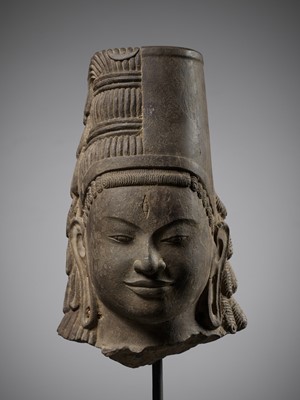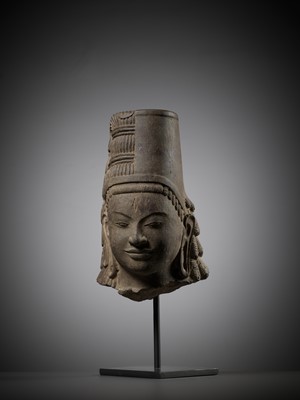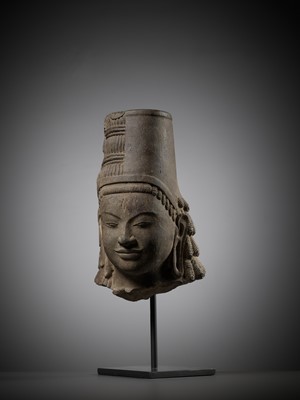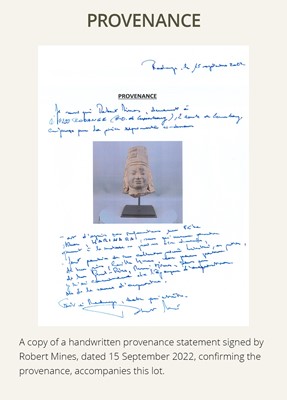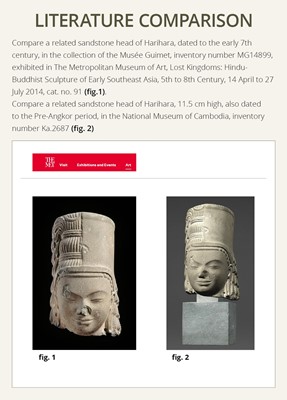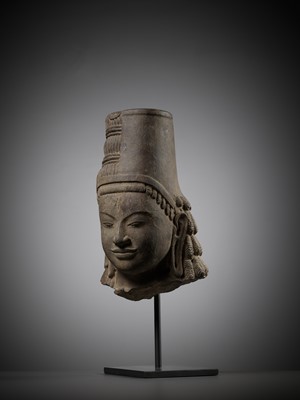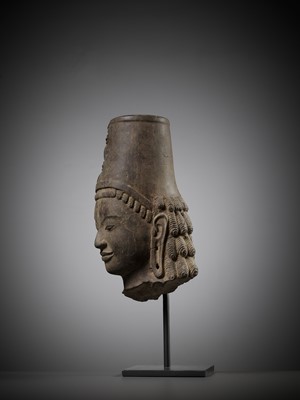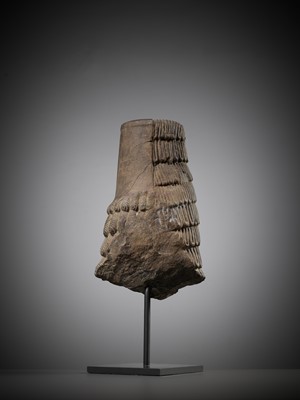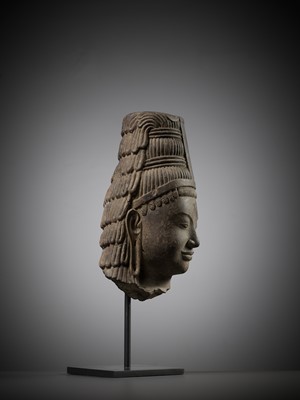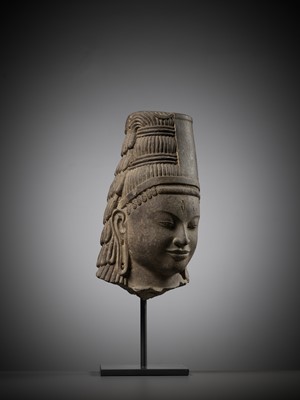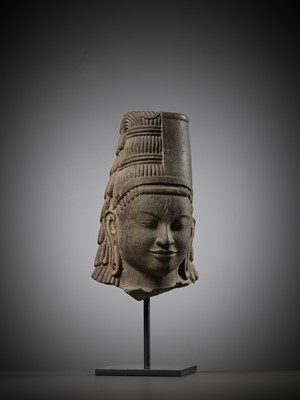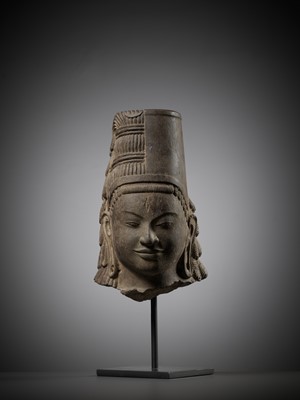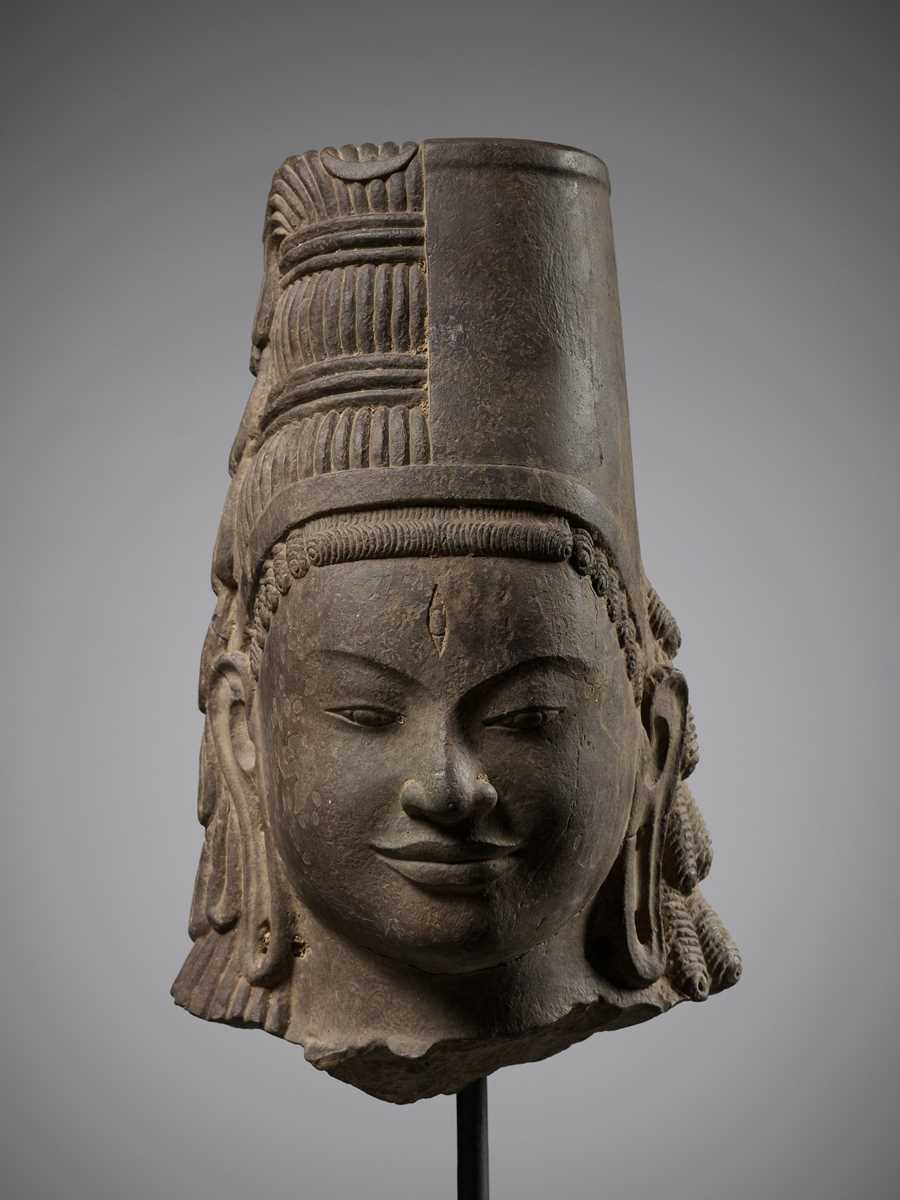9th Mar, 2023 13:00
TWO-DAY AUCTION - Fine Chinese Art / 中國藝術集珍 / Buddhism & Hinduism
223
A RARE SANDSTONE HEAD OF HARIHARA, PRE-ANGKOR PERIOD
Sold for €16,900
including Buyer's Premium
7th to late 8th century. Finely carved with a serene expression, almond-shaped eyes with neatly incised pupils, and full lips forming a subtle smile, flanked by long pendulous earlobes. The hair is partly jatamakuta (braided) and partly kiritamakuta (cylindrical), representing Shiva and Vishnu, respectively.
Provenance: From the private collection of Camille Mines (1950-2018), Luxembourg. By repute acquired by his father, René Mines, in the local trade during the early 1970s. By descent to Robert Mines. A copy of a handwritten provenance statement signed by Robert Mines, dated 15 September 2022, confirming the above, accompanies this lot.
Condition: Good condition, commensurate with age. Extensive wear, cracks, losses, nicks, scratches, signs of weathering and erosion, encrustations.
Dimensions: Height 30 cm (excl. stand), height 41 cm (incl. stand)
Mounted to a modern stand. (2)
Syncretism is a favored device in Indian cosmologies for representing the complex and multifaceted personalities of the gods. The oldest archaeological evidence of this practice is sculptures from Kushana-era Mathura (late 1st – 3rd century), northern India, depicting Shiva combined with his female aspect, Parvati, as the androgynous Ardhanarishvara. Vishnu (Hari) combined with Shiva (Hara) appeared later in India, in the fifth century during the Gupta period, and is explained mythically as Shiva representing the male half of the universe and Vishnu, in his female aspect as Mohini, representing the female element. Harihara is born of their sexual union.
The artistic styles that developed during the Pre-Angkor period, before the capital was moved north to Angkor, exhibit a wider range of artistic motifs than those that would develop during the Angkor period. Phnom Da was an important center of artistic creation during the 6th-7th centuries.
Literature comparison:
Compare a related sandstone head of Harihara, 11.5 cm high, also dated to the Pre-Angkor period, in the CB National Museum, inventory number Ka.2687. Compare a related sandstone head of Harihara, dated to the early 7th century, in the collection of the Musée Guimet, inventory number MG14899, exhibited in The Metropolitan Museum of Art, Lost Kingdoms: Hindu-Buddhist Sculpture of Early Southeast Asia, 5th to 8th Century, 14 April to 27 July 2014, cat. no. 91.
7th to late 8th century. Finely carved with a serene expression, almond-shaped eyes with neatly incised pupils, and full lips forming a subtle smile, flanked by long pendulous earlobes. The hair is partly jatamakuta (braided) and partly kiritamakuta (cylindrical), representing Shiva and Vishnu, respectively.
Provenance: From the private collection of Camille Mines (1950-2018), Luxembourg. By repute acquired by his father, René Mines, in the local trade during the early 1970s. By descent to Robert Mines. A copy of a handwritten provenance statement signed by Robert Mines, dated 15 September 2022, confirming the above, accompanies this lot.
Condition: Good condition, commensurate with age. Extensive wear, cracks, losses, nicks, scratches, signs of weathering and erosion, encrustations.
Dimensions: Height 30 cm (excl. stand), height 41 cm (incl. stand)
Mounted to a modern stand. (2)
Syncretism is a favored device in Indian cosmologies for representing the complex and multifaceted personalities of the gods. The oldest archaeological evidence of this practice is sculptures from Kushana-era Mathura (late 1st – 3rd century), northern India, depicting Shiva combined with his female aspect, Parvati, as the androgynous Ardhanarishvara. Vishnu (Hari) combined with Shiva (Hara) appeared later in India, in the fifth century during the Gupta period, and is explained mythically as Shiva representing the male half of the universe and Vishnu, in his female aspect as Mohini, representing the female element. Harihara is born of their sexual union.
The artistic styles that developed during the Pre-Angkor period, before the capital was moved north to Angkor, exhibit a wider range of artistic motifs than those that would develop during the Angkor period. Phnom Da was an important center of artistic creation during the 6th-7th centuries.
Literature comparison:
Compare a related sandstone head of Harihara, 11.5 cm high, also dated to the Pre-Angkor period, in the CB National Museum, inventory number Ka.2687. Compare a related sandstone head of Harihara, dated to the early 7th century, in the collection of the Musée Guimet, inventory number MG14899, exhibited in The Metropolitan Museum of Art, Lost Kingdoms: Hindu-Buddhist Sculpture of Early Southeast Asia, 5th to 8th Century, 14 April to 27 July 2014, cat. no. 91.
Zacke Live Online Bidding
Our online bidding platform makes it easier than ever to bid in our auctions! When you bid through our website, you can take advantage of our premium buyer's terms without incurring any additional online bidding surcharges.
To bid live online, you'll need to create an online account. Once your account is created and your identity is verified, you can register to bid in an auction up to 12 hours before the auction begins.
Intended Spend and Bid Limits
When you register to bid in an online auction, you will need to share your intended maximum spending budget for the auction. We will then review your intended spend and set a bid limit for you. Once you have pre-registered for a live online auction, you can see your intended spend and bid limit by going to 'Account Settings' and clicking on 'Live Bidding Registrations'.
Your bid limit will be the maximum amount you can bid during the auction. Your bid limit is for the hammer price and is not affected by the buyer’s premium and VAT. For example, if you have a bid limit of €1,000 and place two winning bids for €300 and €200, then you will only be able to bid €500 for the rest of the auction. If you try to place a bid that is higher than €500, you will not be able to do so.
Online Absentee and Telephone Bids
You can now leave absentee and telephone bids on our website!
Absentee Bidding
Once you've created an account and your identity is verified, you can leave your absentee bid directly on the lot page. We will contact you when your bids have been confirmed.
Telephone Bidding
Once you've created an account and your identity is verified, you can leave telephone bids online. We will contact you when your bids have been confirmed.
Classic Absentee and Telephone Bidding Form
You can still submit absentee and telephone bids by email or fax if you prefer. Simply fill out the Absentee Bidding/Telephone bidding form and return it to us by email at office@zacke.at or by fax at +43 (1) 532 04 52 20. You can download the PDF from our Upcoming Auctions page.
How-To Guides
How to Create Your Personal Zacke Account
How to Register to Bid on Zacke Live
How to Leave Absentee Bids Online
How to Leave Telephone Bids Online
中文版本的操作指南
创建新账号
注册Zacke Live在线直播竞拍(免平台费)
缺席投标和电话投标
Third-Party Bidding
We partner with best-in-class third-party partners to make it easy for you to bid online in the channel of your choice. Please note that if you bid with one of our third-party online partners, then there will be a live bidding surcharge on top of your final purchase price. You can find all of our fees here. Here's a full list of our third-party partners:
- 51 Bid Live
- EpaiLive
- ArtFoxLive
- Invaluable
- LiveAuctioneers
- the-saleroom
- lot-tissimo
- Drouot
Please note that we place different auctions on different platforms. For example, in general, we only place Chinese art auctions on 51 Bid Live.
Bidding in Person
You must register to bid in person and will be assigned a paddle at the auction. Please contact us at office@zacke.at or +43 (1) 532 04 52 for the latest local health and safety guidelines.
